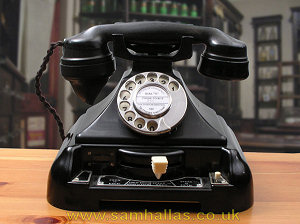
Sam Hallas' Website
The 162 started off the Bakelite revolution that set the pattern for telephone design right up until the introduction of the 700 series telephones in 1957. Its clean lines and smooth curves give it a modern "art deco" look. The mechanical design is robust, simple and reliable with fairly few parts. It is easy to replace cords and fairly easy to replace other parts with a minimum of tools.

I find it disappointing that the 162 didn't use a hybrid transformer in the transmission circuit when the principle was already well-known. Official publications [Ref 2b & 4] of the time suggest that there was a need to use up excess stocks of Bellset No 1. With hindsight I think it an unfortunate decision driven by financial rather than engineering considerations. The Bellset No 1 can be easily modified to remove the transformer from circuit, making a wooden cased version of Bellset 26. The 232 remedies the deficiency, but the need for a bulky bellset meant that it's days were numbered. The prototype for the self-contained telephone with a one-piece moulding was already in production by Ericssons. Its successor, the BPO Tele No 332 was released in 1936 just two years after the 232 came out. However, coupled with Bellset No 39 the 200 series remained in existence as the means of providing extension plans 5 and 7 until the introduction of the Planphone No 1, using Planset N625.
Thanks to the Queen Mother Theatre, Hitchin, for donating the two telephones from their cast-off props department. But no thanks to them for spray painting them white!
Other acknowledgements are due to Peter Walker and Bob Freshwater for historical and technical information (see References below) and especially to Ron Sewell for proofreading the whole thing, improving the sense of the text and putting me right on various technical details.
 Previous
Project Title Page
Previous
Project Title Page